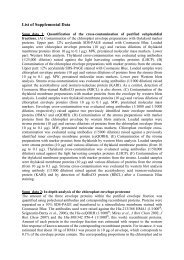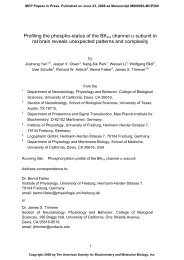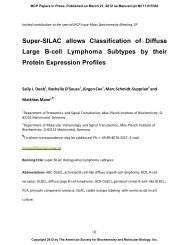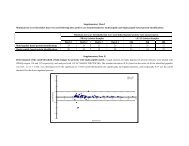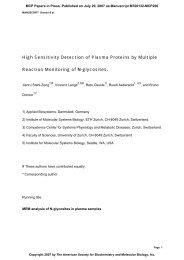MSDaPl - Molecular & Cellular Proteomics
MSDaPl - Molecular & Cellular Proteomics
MSDaPl - Molecular & Cellular Proteomics
You also want an ePaper? Increase the reach of your titles
YUMPU automatically turns print PDFs into web optimized ePapers that Google loves.
for the quality of the mass spectrometry experiment (Figure 4b). The graphs indicate the<br />
proportion of PSMs with q-values better than a given cutoff to all PSMs and the<br />
proportion of MS/MS scans that resulted in a quality PSM to all MS/MS scans.<br />
JOB QUEUE AND DATA IMPORTERS<br />
Software for importing data into <strong>MSDaPl</strong> has been developed and is included in the<br />
<strong>MSDaPl</strong> distribution. The import system has been designed as a job queue system, where users<br />
of the <strong>MSDaPl</strong> web interface submit requests to upload data and these requests are saved to the<br />
database as jobs to be completed by a separate Java program. This program is responsible for<br />
querying for new jobs, transferring the data, importing the data to the <strong>MSDaPl</strong> database, and<br />
notifying the user when complete. The pending and completed jobs may be viewed and managed<br />
via the web interface. The import program currently supports files with the following formats:<br />
• XML (mzML, mzXML, mzIdentML, pepXML(5), protXML(5), and Percolator)<br />
• MS1, MS2, and compressed MS2 (CMS2)<br />
• SQT<br />
The import libraries for each of these formats implement a common interface that may be<br />
implemented by other developers to add support for other file formats to the import system.<br />
Additionally, jobs may be submitted to the job queue system directly via web services in order to<br />
better support command-line programs or automated proteomics pipelines.<br />
FASTA PARSER<br />
As described in the “DATA ARCHITECTURE” section, <strong>MSDaPl</strong> makes use of a<br />
database (“NR_SEQ”) to map the accession strings present in specific FASTA files to internal<br />
protein identification numbers, in order to unambiguously refer to the same protein across<br />
experiments and to provide current and preferred naming and annotations for those proteins in<br />
16



